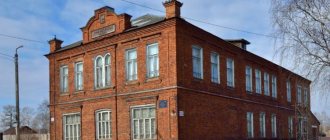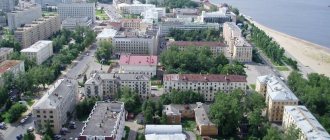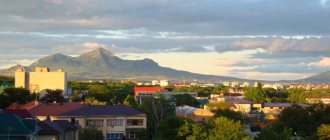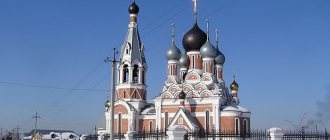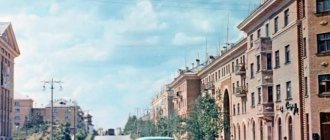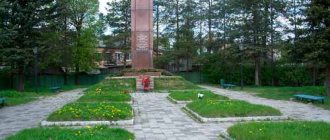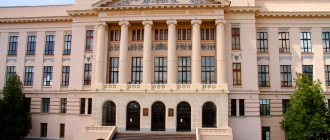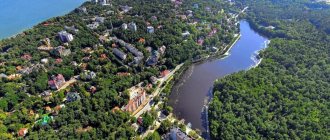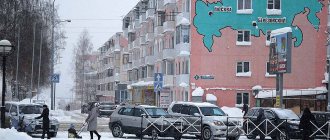So, where is the city of Kotlas? Few people know that in the distant past, namely in the 9th century, on the site of the modern city there was a dense and impenetrable forest. Only on the right Bank of the Northern Dvina, somewhat south of where the Vycheda flows into it, was there a small settlement. Today Kotlas is a city in the Arkhangelsk region, an administrative center with a population of more than 60,000 people. For many, the city may seem quite small and uninteresting, but within the framework of this material we will not only tell you where the city of Kotlas is located, but also introduce you to its amazing history.
Historical reference
For the first time, the current Kotlas (Arkhangelsk region) was mentioned as a settlement in 1379. At that time, Komi tribes lived on this land. It was through this settlement in the 14th century that trade routes from Siberia, Arkhangelsk and the central regions of the country passed. But even the excellent location of the city did not contribute to its development and prosperity; Kotlas remained a tiny and almost invisible town for a long time.
A turning point in the history of the city was steam shipping, which contributed to its development. And with the construction of the railway in the region, Kotlas completely turned into a developed transport hub.
What is the glorious city of Kotlas today? Its economy, as in its heyday, is closely connected with the railway industry. It brings the main income to the city budget.
City symbols
| In a steel-colored field, representing the North, there is a three-pointed blue star, bordered by a narrow gold stripe, a symbol of the confluence of 2 rivers: the Vychegda and the Northern Dvina, where the city is located. The star is enclosed by a golden half-gear, next to which are golden emblems symbolizing air, rail and river transport. At the bottom of the coat of arms is a small golden herringbone. The coat of arms is crowned by the flag of the RSFSR, on the blue stripe of which is the date of the city’s formation “1917”, and on the red stripe is the name of the city “KOTLAS”. Letters, numbers and narrow gold border. The coat of arms tells that the city is a large industrial center, a transport hub with a complex of woodworking enterprises |
| In a scarlet field there is an azure three-rayed star edged with gold, the upper ray of which is burdened with a gold star with eight rays and is accompanied on the sides by two of the same stars and above them by two golden fir trees; on top of everything is a golden winged railway wheel (the wheel is in the center of a three-rayed star, the wings extend beyond it below the stars accompanying its upper ray). |
The Regulations on the Coat of Arms of Kotlas gives the interpretation of the coat of arms:
Vowel coat of arms. Translated from the Zyryan language, Kotlas (Kodlas) means “entrance”. This is truly the gateway to the North, to Siberia, to Chud Zavolotskaya. This is a large industrial and transport hub of the European North of Russia. The three rays of the star symbolize the center of three large rivers, at the intersection of which Kotlas was formed. Three stars indicate villages that were originally included in the city: Zhernakovo, Osokorikha, Petrukhonskaya. The arc-shaped arrangement of stars means the largest bridges in the region across the Northern Dvina - road and railway. The winged wheel represents railway transport, the development of which gave impetus to the formation of the city. Fir trees are a sign of the forest region, as well as timber processing. The dominant golden color of the elements of the coat of arms symbolizes the rise, prosperity, and progress of the developing city.
What to see
Many sincerely believe that the city of Kotlas (Arkhangelsk region), despite its rich history, cannot boast of iconic places that every guest must visit. But we intend to refute this information.
The Kotlas Local Lore Museum is perhaps the main attraction of the city; all the secrets of its formation and development are kept here. If you want to get to know the city better and discover its secrets, feel free to come here. Outwardly, it is an unremarkable building, not distinguished by the complexity of its design, but this is where history is kept.
The private motorcycle museum is another interesting place. The exhibition features motorcycles, mopeds from various times and eras, as well as photographs from major motocross exhibitions and competitions. Surely, enthusiastic guests of the city will be interested in visiting this attraction.
All connoisseurs of the spiritual component should look into the St. Stephen's Monastery, consecrated in 1829. The Church of St. Nicholas the Wonderworker is another holy place of the city, located within walking distance from its center. Be sure to take a walk to the temple.
Kotlaslag
On June 6, 1931, the “Kotlas transit point of the Ust-Vym ITL OGPU” was formed. His profile was the storage of goods and their transportation to the camps of the Komi Autonomous Soviet Socialist Republic and the re-sending of prisoners. [8] Since 1938, the Kotlas transfer was an independent institution of the Gulag. Since May 1940, the transit point was transformed into the Kotlas department of the Main Directorate of Railway Construction Camps of the GULZhDS. From that time on, the number of prisoners ranged from 6 to 7 thousand. [9] :p. 411
How to get there
We figured out that Kotlas is a city in the Arkhangelsk region. But it is not enough to answer the question of where the city of Kotlas is, it is important to understand how to get to it.
Despite the fact that the city is quite small, transport links with it are excellent. Just a few kilometers east of the city, planes from Moscow, Arkhangelsk, St. Petersburg, Murmansk and other cities of the country regularly land. Thus, you do not have to buy plane tickets to Arkhangelsk, and then travel a long way by car or bus - you can immediately purchase a ticket for a direct flight to Kotlas.
For an impressive period of time, the glorious city of Kotlas was the most important transport hub, and it has retained its status to this day. Due to the developed railway communication, you can easily get to Arkhangelsk and Moscow; the St. Petersburg - Vorkuta train passes through the railway station several times a week.
If you decide to get to Arkhangelsk, you can do this not only by train, but also by bus, which departs from the city’s bus station twice a day. Buses depart from Kotlas to Veliky Ustyug 8 times a week, and to Vologda three times a week. The Arkhangelsk-Kotlas route can also be covered by rail and buses. True extreme sports enthusiasts and tourists who love to discover everything new and unknown can use water transport. Provided the river is deep enough, you can get from Arkhangelsk to Kotlas by boat, departing twice a week. Prepare for a long journey: going down the river, the journey will take 49 hours, in the opposite direction - 64 hours. But such a mini-trip will allow you to enjoy the beauty of the opening landscapes and the freshness of the northern air.
Kotlas Museum of Local Lore
The building of the Kotlas Local Lore Museum (Vinogradova St., 22) is a historical and cultural monument, built in 1906. A wooden two-story building, built as a cultural and educational center for the Kotlas railway station and nearby villages - the people's house of the temperance society. Here lectures were given with illustrations shown through a projection lamp, billiards were played, and performances were staged. In 1917 - an administrative building: until October 1917 - the Council of the RSKD of Kotlas was located. After the February Revolution, from March to October 1917, the people's house came under the jurisdiction of the Kotlas Council. There were clubs for workers, performances, evenings and meetings were held there. In October 1917, Soviet power was proclaimed in this building. During the Civil War, on the ground floor there was a club named after. Lenin, where a military garrison was located, detachments of Red Army soldiers were formed to be sent to the front, and military training was carried out. On the 2nd floor, Komsomol members organized a drama club. In the 1920s. "Torgsin" (trading syndicate), the "Fabrics" store, religious goods and living quarters, the people's court. In subsequent years, the building was used by various departments. In 1978, at the request of party and Komsomol veterans, the building housed a historical and revolutionary museum - a branch of the Arkhangelsk Regional Museum of Local Lore. Since 1990, it received the status of a state museum of local lore. Since 1978 - the state historical and revolutionary museum, later - a local history museum.
St. Stephen's Cathedral
The only architectural monument of regional significance in the city is St. Stephen's Church. In the past, on the site of the modern St. Stephen's Church there was a wooden chapel, erected by the preacher Stefan of Perm in 1379. When the chapel began to not accommodate parishioners, it was decided to change the chapel to a wooden church. In 1776 the church burned down. On March 5, 1777, residents of the Kotlas district at a meeting decided to build a stone church. The difficulty was that there were no specialists in the construction of brick buildings; the peasants did not know how to burn bricks and lay them. For lime we had to go to the Sukhona and “to Komaritsa”. Temples of that time were usually built without drawings, they simply looked at other churches to see which one they liked, and did so. Probably, Stephen's Church was built this way. Money for construction was collected all over the world. It took a long time to build. The first floor (warm temple) was completed in 1785. The first floor would have a Baroque architectural style. There was a long break between the construction of the first and second floors, which was common in northern Russian architecture of the 18th century. The second floor was presumably completed in 1805. By that time, the rules for the construction of temples had changed: now a drawing and a certificate of “education” of the master were required. The architectural style also changed; the rich decorations of the Baroque were replaced by strict, restrained classicism. The second floor of the temple was built in the style of early classicism: flat decoration, strict triangular pediments. To avoid disharmony, the first floor had to be slightly remodeled; the old platbands were removed and new ones were made, flat, but more complex than those of the upper church. The author of the architectural design of the second floor is not known for certain. Perhaps it was the provincial architect Vokht, who at that time was the author of most of the projects. The bell tower, unlike the church, is decorated with columns and is attractive with the softness and plasticity of its rounded volumes. Date of construction: 1825. St. Stephen's Church is one of the first religious buildings in the North containing forms of classical architecture. In its likeness, similar churches subsequently began to appear in the Russian North. During the Soviet years, various enterprises were located in the church buildings: a dairy kitchen, a mill, a creamery, a carpentry and cooperage workshop, and commercial warehouses. In 1988, the large temple, being in disrepair, collapsed. Only the bell tower stood. The large temple was again restored according to old drawings in 1995.
Monument to participants of the civil war, heroes of the North Dvina military river flotilla
A historical monument to the soldiers of the North Dvina military river flotilla in Kotlas was erected on the banks of the Malaya Dvina not far from the local history museum. Its authors are architect I. A. Shadrin and sculptor - Honored Artist of the RSFSR Valentin Andreevich Mikhalev (he spent his childhood and youth in Arkhangelsk, lived in Moscow). Made by specialists from Rosmonumentart. The total height of the monument is 16 meters, the material is sheet copper. This is a sculptural composition of four figures. Pavlin Vinogradov, a sailor, a peasant partisan and a woman commissar, located around an unfurled banner, personify the victory of the heroes of the civil war in the North. Opened November 1, 1987. At the opening ceremony, the text of the address to the Kotlashans of 2021 was read out, which was enclosed in a special capsule and walled up at the foot of the monument. The monument is considered unfinished. According to the authors’ plans, the approach to the monument from Vinogradova Street should have been decorated with two strict pylons with cartouches mounted on them with text about the exploits of the Severodvinsk rivermen, a viewing platform on the Dvina should be built, the cladding should be completed and the area around the monument should be landscaped. None of this was done.
Monuments to N. G. Kuznetsov
A bust of Nikolai Gerasimovich Kuznetsov, admiral of the Soviet Union Fleet, Hero of the Soviet Union, a native of the village of Medvedka, Kotlas district, was unveiled on Mayakovsky Street (near the House of Children's Creativity). The opening took place on July 16, 2004 in honor of the centenary of the birth of his fellow countryman. The initiative to build the bust belongs to the committee of war veterans and military service and the city headquarters of schoolchildren “Comrade”. Funds for the monument were allocated by the Navy headquarters, city and regional authorities, city and district enterprises, as well as city residents. The sculptor of the monument is Pyotr Abarin. Bust height - 1.35 m. Bust weight - almost 500 kg. Made in the classical style, cast in the city of St. Petersburg at the Monumentsculpture art casting plant. The granite parts of the pedestal are monolithic and delivered from the city of Kondopoga in the Karelian Republic. The weight of the pedestal is about 8.5 tons, the height of the pedestal is 2.3 m. A memorial capsule with an appeal to future generations was laid at the base of the monument. One of the streets in the city was named after N.G. Kuznetsov, and therefore in October 1977 a memorial plaque was unveiled at house No. 1 on the street named after the hero. In 1988, the memorial plaque was re-opened. The reason was new data from the biography of N. G. Kuznetsov. The year of birth of the famous fellow countryman was clarified in the archives, and Nikolai Gerasimovich was restored to the rank of Admiral of the Fleet of the Soviet Union. The name of Admiral Kuznetsov is engraved on the memorial wall in honor of the Kotlashans-Heroes of the Soviet Union in the city park.
Monuments of technology
The ZIS-5 truck is immortalized on the territory of the Motor Column. This truck was once a fire truck at the river port. After it was written off, Avtokolonna took it in to preserve it. For some time, the ZIS-5 was a simulator at the training plant. Then it was completely restored and placed on a pedestal. The restoration was carried out by the head of the workshops S.N. Tolstopyatov with young mechanics.
In 2007, an armored personnel carrier was installed near a house on Kirova Street. This is the property of the limited liability company "OST-1". Brought from Veliky Ustyug.
In the summer of the same year, a historical steam locomotive was placed on the station square - a gift to the city for its 90th anniversary from the railway. The L series locomotive No. 5129 was built in 1950. Its length is almost 24 meters and its weight is more than 90 tons. From 1955 to 1972 he worked in the Kotlas-Kirov, Kotlas-Konosha, Kotlas-Vorkuta sections. Before being placed on the pedestal, the locomotive was located in the locomotive depot of the Solvychegodsk station. Restored and installed by restoration train No. 3444 of the locomotive depot.
In 2009, on Serafimovich Street in the old hospital town, a Zaporozhets car with a red cross was placed on a pedestal. This is a “Zaporozhets” of the first release, once owned by a private person. Employees of the medical transport sector made this rarity the business card of the enterprise. The car is raised on a pedestal as an identification mark to make it easier to find the company. The red stripe and red cross are like belonging to an ambulance transport.
Sculptural structures
On the square in front of the city administration there is a composition with the very symbolic name “Glory to Labor”, installed in 1980. Sculptor T. V. Dmitrieva. Labor is glorified by two male figures - a river worker and a builder. These were once the most popular professions in the city.
The sculpture of another builder is located near the Kotlas sawmill and woodworking plant
The figure of a partisan girl symbolizes all the Komsomol members who tragically died during the Great Patriotic War. Initially it was installed near school No. 82. Then it was moved to the Makarovo cemetery.
The swan sculpture appeared in the City Park pond in 2008.
A sculptural composition made of metal ribbons decorated the façade of the Gamma Art School. Its authors are Andrey and Inna Slibo. The composition was made by students and craftsmen of vocational school No. 20. It was installed in 2009.
The sculptural composition “Tree of Love” was opened in the City Park in 2010.
In August 2013, a sculpture of a housewife appeared near the building of the Kotlasgazservice organization. Made by masters of the forge “Kovka 29” in the village of Vychegodsky. Project manager Andrey Malov, design - Sergey Elezov, master Ilya Kononenko.
Based on materials from the Kotlas centralized library system
Where to stay
When going to any city, it is important to resolve the issue of housing in advance. There are very few hotels in Kotlas, but if you book a room of the required category, you will save yourself from numerous difficulties.
"Sovetskaya" - the largest hotel in the city - offers guests more than 200 rooms of various price categories. It is located in the city center, so it will be an excellent option for tourists and business travelers. The cost of daily accommodation starts from 1300 rubles, the rooms are not equipped with the most modern furniture and appliances, but in order to relax and recuperate, it is a good option.
If you are a connoisseur of first-class service and want to stay in a beautiful hotel room with all the necessary amenities, pay attention to the Sapphire Hotel. 49 cozy rooms furnished with modern stylish furniture and appliances are the best that guests of the city can find. It is here that businessmen and business travelers often stop, and this is largely due to the presence of a conference room for business negotiations and meetings, as well as a chic restaurant on the ground floor.
Population
Population
| Year | Population |
| 1911 | 600 |
| 1926 | 4000 |
| 1931 | 5500 |
| 1939 | 17 300 |
| 1959 | 52 608 |
| 1962 | 56 000 |
| 1967 | 61 000 |
| 1970 | 55 661 |
| 1979 | 61 454 |
| 1989 | 68 021 |
| 2002 | ? |
| 2010 | 60 562 |
| Source | |
Koryazhma is an old and small town
This is one of the ancient cities in the region, which was developed in the 16th century. There is a cellulose processing plant here, which is one of the main enterprises of the settlement. The population, according to 2021 data, was only 37 thousand inhabitants.
Negative dynamics have been observed since 1998. The city administration promises to correct the demographic situation. This locality plans to introduce an affordable housing program.
Kotlas
7 materials on 3 objects, 91 photographs
You can follow all new publications on any country or city using the feeds on your personal page, as well as using an RSS subscription. More details
Use this code to insert a link to this destination into the text of a travel note, advice, blog post or forum post on Turbine. More details
This list includes the authors who received the highest ratings for materials about Kotlas.
Add the user as a friend if you want to follow his new materials, statuses and messages on the forums. If you just want to save the user’s data so as not to search for him again in the future, add him to your contacts .
Notes
- from the point of view of the administrative-territorial structure
- from the point of view of the municipal structure
- ↑ 1234
The permanent population of the Russian Federation by municipalities as of January 1, 2021 (Russian). Date accessed: April 27, 2021. Archived May 2, 2021. - OKTMO. 185/2016. Northwestern Federal District
- Law of the Arkhangelsk Region “On the administrative-territorial structure of the Arkhangelsk Region” (as amended on June 29, 2015)
- Charter of the Arkhangelsk Region
- Charter of the municipal formation "Kotlas"
- Official names: municipal formation “Kotlas”, municipal district “Kotlas”
- ↑ 12
Regional Law “On the status and boundaries of municipalities of the Arkhangelsk region” N 258-extra-OZ of 2004 - List of regions of the Far North and equivalent areas
- Residents of the village of Vychegodsky will be able to choose their status, Dvina-Inform (July 9, 2004). Retrieved February 2, 2011.
- Kotlas+Vychegdsky, Evening Kotlas (July 29, 2004). Retrieved February 2, 2011. (inaccessible link)
- Stop the Vychegda separatists!, Pravda Severa (September 21, 2004). Retrieved February 2, 2011.
- Law of the Arkhangelsk Region of September 23, 2004 No. 258-extra-OZ “On the status and boundaries of the territories of municipalities in the Arkhangelsk Region”
- The status of Kotlas may change (Arkhangelsk region), Regnum news agency (February 5, 2005). Retrieved February 2, 2011.
- Law of the Arkhangelsk Region “On the status and boundaries of the territories of municipalities in the Arkhangelsk Region” (version dated March 3, 2005)
- All-Russian population census 2002. Volume. 1, table 4. Population of Russia, federal districts, constituent entities of the Russian Federation, districts, urban settlements, rural settlements - regional centers and rural settlements with a population of 3 thousand or more (unspecified)
. Archived from the original on February 3, 2012. - Arhangelsk region. Estimation of the resident population as of January 1, 2008 - 2015
- The size of the permanent population of the Russian Federation by cities, urban settlements and regions as of January 1, 2009 (unspecified)
. Retrieved January 2, 2014. Archived January 2, 2014. - ↑ 123
All-Russian population census 2010. Number of municipalities and settlements of the Arkhangelsk region - Population by municipalities of the Arkhangelsk region as of January 1, 2011 (unspecified)
. Retrieved May 4, 2014. Archived May 4, 2014. - Population of the Russian Federation by municipalities. Table 35. Estimated resident population as of January 1, 2012 (unspecified)
. Retrieved May 31, 2014. Archived May 31, 2014. - Population of the Russian Federation by municipalities as of January 1, 2013. - M.: Federal State Statistics Service Rosstat, 2013. - 528 p. (Table 33. Population of urban districts, municipal districts, urban and rural settlements, urban settlements, rural settlements) (undefined)
. Retrieved November 16, 2013. Archived November 16, 2013. - Table 33. Population of the Russian Federation by municipalities as of January 1, 2014 (unspecified)
. Access date: August 2, 2014. Archived August 2, 2014. - Population of the Russian Federation by municipalities as of January 1, 2015 (unspecified)
. Access date: August 6, 2015. Archived August 6, 2015. - Population of the Russian Federation by municipalities as of January 1, 2021 (Russian) (October 5, 2018). Date accessed: May 15, 2021. Archived May 8, 2021.
- Population of the Russian Federation by municipalities as of January 1, 2021 (Russian) (July 31, 2017). Retrieved July 31, 2021. Archived July 31, 2021.
- Population of the Russian Federation by municipalities as of January 1, 2021 (Russian). Retrieved July 25, 2018. Archived July 26, 2021.
- Population of the Russian Federation by municipalities as of January 1, 2021 (Russian). Date accessed: July 31, 2019. Archived May 2, 2021.
- Population of the Russian Federation by municipalities as of January 1, 2021 (Russian). Date accessed: October 17, 2021. Archived October 17, 2021.
- MAIN INDICATORS OF THE SOCIO-ECONOMIC SITUATION OF THE MUNICIPALITY "KOTLAS" FOR THE 1st QUARTER OF 2021
- The city of Kotlas acquired a new coat of arms, Dvinskaya Pravda (October 9, 2007). Retrieved December 4, 2010.
- Regulations on the coat of arms of the city of Kotlas
- Kotlas will have its own anthem, Dvina-Inform (February 25, 2010). Retrieved December 4, 2010.
- Resolution No. 237 of May 27, 2010 On the decision “On approval of the regulations on the anthem of the municipal formation “Kotlas””
- Decision of the Meeting of Deputies of the Municipal Formation “Kotlas” dated 02.17.2011 No. 129-385-r On the adoption of the decision “On the regulation on the flag of the municipal formation “Kotlas””
Economy
The basis of the Kotlas economy is the railway and related enterprises. This industry brings 40-45% of all revenues to the budget of the Kotlas municipality. The main enterprise, the Solvychegodsk branch of the Northern Railway, is located in the village of Vychegodsky. In the field of railway transport there is a constant demand for qualified personnel, and salaries are higher than the city average.
The share of industry in the sectoral structure of the Kotlas economy is 16%. Most enterprises of the Soviet period managed to maintain their profile during the transition to a market economy. The exceptions were a meat processing plant, which was sold in parts after bankruptcy, and a bakery plant, which turned out to be too large for modern conditions. Probably, the intervention of the local administration, which controlled all bankruptcy procedures and the appointment of managers and helped in finding investors, helped to avoid other bankruptcies. However, some enterprises have reduced production volumes and range.
The bridge across the Northern Dvina, built in 2001, provided a road connection between Kotlas and Arkhangelsk, Vologda, Kirov, etc. On the one hand, this served as an impetus for the development of industry and an increase in production volumes, on the other hand, it increased competition by bringing goods from other countries to the Kotlas market. cities.
A serious problem for the Kotlas economy is the lack of electricity production in the city. The price of electricity in the region is 80% higher than in neighboring regions. The city is supplied with electricity from the Severodvinsk and Arkhangelsk thermal power plants, which operate on imported coal and fuel oil, and the power center of the Kotlas Pulp and Paper Mill, which runs on gas. [26] The installation of a high-pressure gas pipeline to Arkhangelsk and Severodvinsk should reduce production costs and have a positive impact on the development of industry in the city.
The main industries of Kotlas: mechanical engineering and metalworking (49%), forestry and woodworking industries (22%), food (16%).
Climate[edit]
Kotlas has a subarctic climate ( Köppen climate classification Dfc
).
| Climate data for Kotlas | |||||||||||||
| Month | Jan | Feb | Mar | Apr | May | Jun | Jul | Aug | Sep | October | But I | December | Year |
| Average high °C (°F) | −10 (14) | −9 (16) | −1 (30) | 6 (43) | 14 (57) | 20 (68) | 22 (72) | 20 (68) | 12 (54) | 4 (39) | −2 (28) | −7 (19) | 5 (41) |
| Daily average °C (°F) | −14 (7) | −12 (10) | −6 (21) | 1 (34) | 8 (46) | 14 (57) | 17 (63) | 14 (57) | 8 (46) | 1 (34) | −4 (25) | −10 (14) | 1 (34) |
| Average low °C (°F) | −18 (0) | −17 (1) | −10 (14) | −2 (28) | 3 (37) | 8 (46) | 11 (52) | 9 (48) | 4 (39) | −1 (30) | −7 (19) | −14 (7) | −2 (28) |
| Average precipitation, mm (inches) | 32 (1,3) | 22 (0,9) | 21 (0,8) | 37 (1,5) | 43 (1,7) | 56 (2,2) | 72 (2,8) | 68 (2,7) | 50 (2,0) | 53 (2,1) | 43 (1,7) | 39 (1,5) | 535 (21,1) |
| Source: Weatherbase [14] | |||||||||||||
